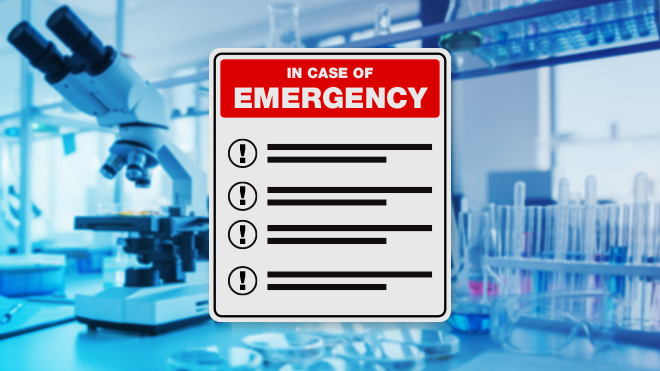Safety Blog
Laboratory Emergency Information Posters
By Ken Roy
Posted on 2024-12-20

Disclaimer: The views expressed in this blog post are those of the author(s) and do not necessarily reflect the official position of the National Science Teaching Association (NSTA).
Introduction
Emergency information posters (EIPs) in a laboratory or classroom instructional space are critical for ensuring safety and quick response during emergencies. Legal safety standards—such as those of Occupational Safety and Health Administration (OSHA), National Fire Protection Association (NFPA), etc.—and better professional safety practices, such as those of NSTA, the National Science Education Leadership Association (NSELA), the American Chemical Society (ACS), etc.—require EIPs in science, tech ed/engineering, STEM instructional spaces (laboratories and classrooms) and associated locations (e.g., preparation room, storeroom, etc.).
EIP Requirements
By ensuring that EIPs meet specific requirements, teachers and supervisors help maintain a safer working/teaching environment and improve preparedness for any emergencies that may arise in the laboratory or classroom instructional space or associated locations. The requirements for posters typically include the following:
1. Location. Posters should be prominently displayed in easily visible locations, such as near entrances and exits and in common areas where they can be quickly seen by anyone in the instructional space.
2. Content
o Emergency Contacts. Include phone numbers for internal emergency responders (e.g., lab supervisors, safety officers, chemical hygiene officers, administrators, nurses) and external emergency services (e.g., fire department, medical emergency services).
o Emergency Procedures. Clearly outline the steps to take in various emergency situations, such as fires, chemical spills, electrical hazards, and medical emergencies. Fire. Instructions on how to respond to a fire, including the location of fire alarms, extinguishers, and the nearest exits
Chemical Spills. Procedures for handling chemical spills, including the use of spill kits and the location of emergency showers and eyewash stations
Medical Emergencies. Basic first aid procedures and the location of first aid kits
Electrical Hazards. Steps to take in case of electrical emergencies, including how to shut off power if necessary
o Evacuation Routes. Provide a map or clear instructions for evacuation routes and exits. This should include primary and secondary escape routes.
o First Aid Information. Instructions on basic first aid procedures and the location of first aid kits and emergency showers/eyewash stations
3. Clarity and Readability
o Use large, legible fonts and clear, concise language.
o Ensure that the poster is in a language understood by all instructional space employees and students, or provide translations if necessary.
o Use symbols and pictograms where appropriate to convey critical information quickly.
4. Lab-Specific Hazards
o Chemical Safety. Information on handling specific chemicals used in the lab, including hazards and emergency procedures. Examples include acids, bases, flammables, toxins, etc.
o Biological Safety. Instructions for dealing with biological hazards, such as exposure to pathogens or biological spills
o Physical Safety. Instructions for dealing with physical hazards, such as projectiles, springs, glassware, etc.
5. Personal Protective Equipment (PPE)
o Guidelines on what PPE is required in case of an emergency, such as nitrile gloves and indirectly vented chemical splash goggles or safety glasses with side shields
6. Updates and Accuracy
o Regularly review and update the information to reflect any changes in procedures, contact details, or personnel.
o Ensure that the contact information and procedures are current and accurate.
7. Compliance
o Adhere to any relevant legal regulatory standards or guidelines provided by organizations such as OSHA and NFPA or local safety regulations.
o Check for specific better professional safety practice requirements or recommendations from your institution, safety committee, and professional associations (NSTA, ACS, NSELA, etc.)
EIP Resources
Creating and maintaining effective EIPs for laboratories and classroom instructional spaces involves using a range of resources to ensure accuracy, compliance, and clarity. Here are some key resources that are recommended.
1. Regulatory Guidelines (Legal Safety Standards)
o OSHA provides guidelines for emergency preparedness and response, including requirements for emergency information in the workplace. Their website offers resources and standards that can help you develop compliant posters.
OSHA Emergency Preparedness
o NIOSH (National Institute for Occupational Safety and Health). NIOSH provides guidance on laboratory safety and emergency response at https://www.cdc.gov/niosh/index.html.
2. Institutional Safety Guidelines
o Board of Education/School Safety Manuals. Many institutions have specific safety manuals and guidelines that outline the requirements for EIPs. Check your institution’s Chemical Hygiene Officer or health and safety committee.
3. Professional Associations (Better Professional Safety Practices)
o ACS offers resources on laboratory safety and emergency preparedness, including best practices for creating safety posters.
o American Biological Safety Association (ABSA). For laboratories working with biological materials, ABSA provides guidance on biological safety and emergency procedures. See https://absa.org/.
o NSTA provides guidance on laboratory safety and emergency procedures at
https://www.nsta.org/topics/safety.
4. Safety Equipment Suppliers
o Laboratory Safety Supply Companies. Companies that provide safety equipment often offer pre-made EIPs that can be customized. Examples include these:
Fisher Scientific. Fisher Scientific Safety Products
Flinn Scientific. Flinn Scientific Safety Products
5. Online Templates and Tools
o Ready.gov provides templates and guidelines for emergency preparedness that can be adapted for laboratory settings at https://www.ready.gov/.
o Emergency Management Websites. Various emergency management organizations offer templates and guidelines for creating emergency posters. One example is the Federal Emergency Management Agency (FEMA); see https://www.fema.gov/.
6. Design Software
o Canva offers customizable templates that can be used to create professional-looking EIPs at https://www.canva.com/.
o Adobe Spark provides tools to design and customize safety posters at https://www.adobe.com/express/.
7. Safety Consultants
o Hiring a professional safety consultant can help ensure that your EIPs meet all relevant regulations and are effectively designed.
In the End
By leveraging these resources, you can create comprehensive and compliant EIPs that enhance safety and preparedness in your laboratory and classroom instructional spaces, along with associated locations (storerooms, preparation rooms, etc.).
Submit questions regarding health and safety issues in science/STEM instructional spaces to Ken Roy at safersci@gmail.com.
Follow Ken Roy on X: @drroysafersci or on LinkedIn at https://www.linkedin.com/in/dr-ken-roy-07218713/.


